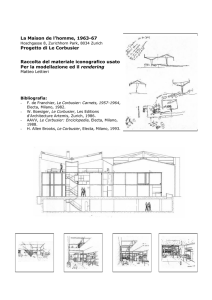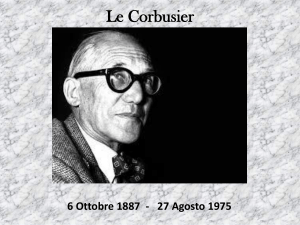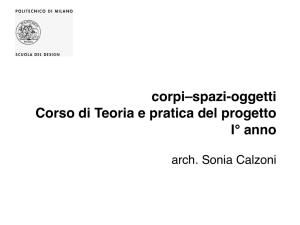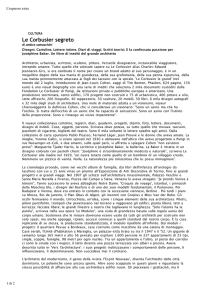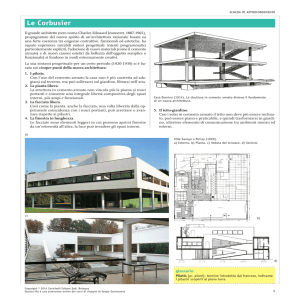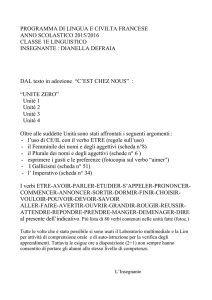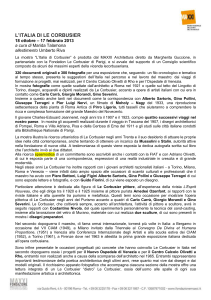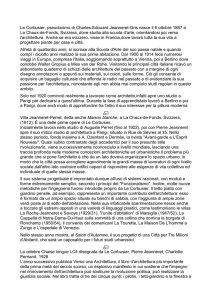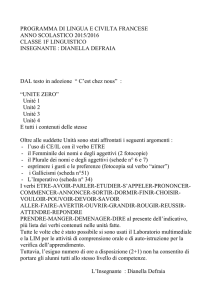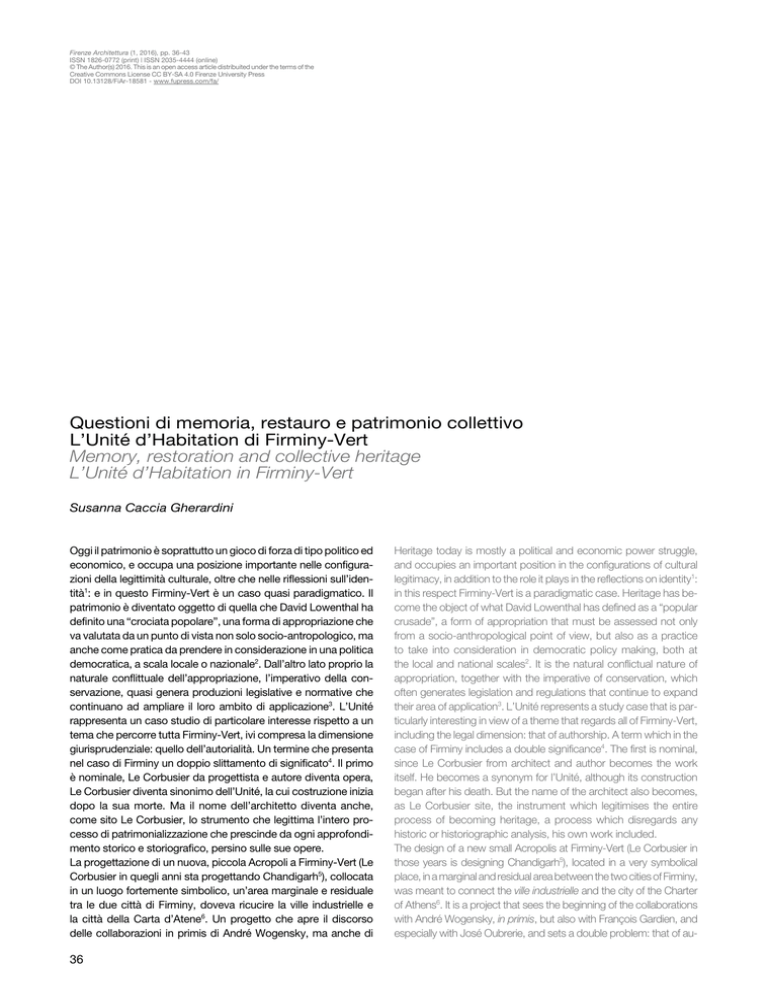
Firenze Architettura (1, 2016), pp. 36-43
ISSN 1826-0772 (print) | ISSN 2035-4444 (online)
© The Author(s) 2016. This is an open access article distribuited under the terms of the
Creative Commons License CC BY-SA 4.0 Firenze University Press
DOI 10.13128/FiAr-18581 - www.fupress.com/fa/
Questioni di memoria, restauro e patrimonio collettivo
L’Unité d’Habitation di Firminy-Vert
Memory, restoration and collective heritage
L’Unité d’Habitation in Firminy-Vert
Susanna Caccia Gherardini
Oggi il patrimonio è soprattutto un gioco di forza di tipo politico ed
economico, e occupa una posizione importante nelle configurazioni della legittimità culturale, oltre che nelle riflessioni sull’identità1: e in questo Firminy-Vert è un caso quasi paradigmatico. Il
patrimonio è diventato oggetto di quella che David Lowenthal ha
definito una “crociata popolare”, una forma di appropriazione che
va valutata da un punto di vista non solo socio-antropologico, ma
anche come pratica da prendere in considerazione in una politica
democratica, a scala locale o nazionale2. Dall’altro lato proprio la
naturale conflittuale dell’appropriazione, l’imperativo della conservazione, quasi genera produzioni legislative e normative che
continuano ad ampliare il loro ambito di applicazione3. L’Unité
rappresenta un caso studio di particolare interesse rispetto a un
tema che percorre tutta Firminy-Vert, ivi compresa la dimensione
giurisprudenziale: quello dell’autorialità. Un termine che presenta
nel caso di Firminy un doppio slittamento di significato4. Il primo
è nominale, Le Corbusier da progettista e autore diventa opera,
Le Corbusier diventa sinonimo dell’Unité, la cui costruzione inizia
dopo la sua morte. Ma il nome dell’architetto diventa anche,
come sito Le Corbusier, lo strumento che legittima l’intero processo di patrimonializzazione che prescinde da ogni approfondimento storico e storiografico, persino sulle sue opere.
La progettazione di un nuova, piccola Acropoli a Firminy-Vert (Le
Corbusier in quegli anni sta progettando Chandigarh5), collocata
in un luogo fortemente simbolico, un’area marginale e residuale
tra le due città di Firminy, doveva ricucire la ville industrielle e
la città della Carta d’Atene6. Un progetto che apre il discorso
delle collaborazioni in primis di André Wogensky, ma anche di
36
Heritage today is mostly a political and economic power struggle,
and occupies an important position in the configurations of cultural
legitimacy, in addition to the role it plays in the reflections on identity1:
in this respect Firminy-Vert is a paradigmatic case. Heritage has become the object of what David Lowenthal has defined as a “popular
crusade”, a form of appropriation that must be assessed not only
from a socio-anthropological point of view, but also as a practice
to take into consideration in democratic policy making, both at
the local and national scales2. It is the natural conflictual nature of
appropriation, together with the imperative of conservation, which
often generates legislation and regulations that continue to expand
their area of application3. L’Unité represents a study case that is particularly interesting in view of a theme that regards all of Firminy-Vert,
including the legal dimension: that of authorship. A term which in the
case of Firminy includes a double significance4. The first is nominal,
since Le Corbusier from architect and author becomes the work
itself. He becomes a synonym for l’Unité, although its construction
began after his death. But the name of the architect also becomes,
as Le Corbusier site, the instrument which legitimises the entire
process of becoming heritage, a process which disregards any
historic or historiographic analysis, his own work included.
The design of a new small Acropolis at Firminy-Vert (Le Corbusier in
those years is designing Chandigarh5), located in a very symbolical
place, in a marginal and residual area between the two cities of Firminy,
was meant to connect the ville industrielle and the city of the Charter
of Athens6. It is a project that sees the beginning of the collaborations
with André Wogensky, in primis, but also with François Gardien, and
especially with José Oubrerie, and sets a double problem: that of au-
37
François Gardien, e soprattutto di José Oubrerie, ponendo un
doppio problema: quello dell’autorialità e, non senza ironia, quello dell’omissione intellettuale che la patrimonializzazione indurrà.
E a Firminy-Vert l’Unité d’habitation diverrà nel linguaggio comune come in quello dei saperi esperti semplicemente Le Corbusier,
come il Patrimonio sarà indicato come Héritage Le Corbusier7.
Le Corbusier viene chiamato da Eugène Claudius Petit soprattutto per progettare tre Unité d’Habitation di cui la prima pietra
dell’unica che sarà completata sarà posta nel maggio del 1965,
pochi mesi prima che Le Corbusier muoia. La progettazione
esecutiva e la costruzione saranno seguite da André Wogensky,
già a capo dell’ACBAT Marsigliese -lo studio che progetterà e
seguirà la costruzione di quell’Unité8- per traslazione di modelli,
intrecciando nella catena patrimoniale nuovamente problemi di
un’architettura fortemente segnata da un’ideologia (abitativa e
progettuale) e question, non certo indifferenti di fronte ad opere
con questa carica programmatica, di autorialità. Gerard Monnier
ha tentato, almeno per la Francia, una storia comparata delle Unité che escono dagli studi di Le Corbusier9. Purtroppo al di là dello
studio di Noël Jouenne proprio su quella di Firminy-Vert10, e degli
studi più generali di Monique Eleb e Jean-Louis Violeu11, il nodo
del rapporto che si genera tra spazio e abitare in architetture così
programmatiche è quasi sfuggito agli antropologi.
L’avvio della certificazione del valore delle architetture Corbuseriane (il primo passo sulla strada del riconoscimento, scriverebbe
Sébastien Dubois)12, non parte dall’alto, non fa leva sulla natura
autoriale delle opere, né vede intervenire dei savants.
Ed è proprio un passaggio che interessa ancora l’Unité ad aiutare
a comprendere in che modo intervenga un sapere esperto tipicamente conservatore, come il restauro, a segnare l’ultima fase della vicenda di Firminy-Vert. Con il riconoscimento di edificio clasée
dell’Unité nel 1993 arrivano infatti anche gli aiuti finanziari per il
restauro di un elemento che segna la grammatica Corbuseriana,
la toit-terrasse, attraverso una campagna di interventi, collocati
tra il 1995 e il 199813. Ma è l’eterogeneità delle gestioni che si susseguono almeno a partire dal 2000 a evidenziare come sia difficile il passaggio dalla carta alle pietre. Dal punto di vista amministrativo l’Unité è divisa in volumi gestiti da strutture diverse: una
comproprietà privata, due comproprietà OPH - Office Public de
l’Habitat - e la “Ville de Firminy”. L’OPH Firminy porta avanti, tra il
2008 e il 2011, il restauro e le trasformazioni di 34 alloggi nell’ala
nord, la parte chiusa nel 1984, in particolare oltre alla messa a
norma dei bagni e degli impianti, attraverso il ridimensionamento
delle cellule (alcune camere sono infatti raggruppate)14: il nesso
che si vuole stabilire è tra memoria architettonica, la rigidità della
distribuzione architettonica e la fragilità degli impianti.
L’assenza dei requisiti minimi di vivibilità è d’altronde una delle
principali cause del progressivo spopolamento dell’Unité stessa15. Sono questi anche gli anni della richiesta di chiusura della
scuola materna, per mancanza di rispondenza alle normative di
sicurezza, dello studio per un parziale cambiamento di funzioni
redatto dal gruppo d’Art et Actualités, delle proposte di grandi
trasformazioni architettoniche, con l’apertura di fenêtres urbaine
su progetto dell’architetto Henri Ciriani, che comporterebbe
però una reinterpretazione dell’edificio16. A contrastare un vero
e proprio tradimento di Le Corbusier, saranno allora i locataires,
con un ribaltamento di ruoli tra saperi esperti (e filologici) e adeguamento al mutare dei quadres de vie, che rappresenta un’altra
delle singolarità dell’intera vicenda di Firminy.
La chiusura della scuola materna in effetti, dopo dieci anni di stremanti opposizioni, avviene nel 1998. Non senza un’involontaria
ironia, a 14 anni di distanza la scuola ha ripreso una sua attività
didattica, grazie all’insediamento di una serie di master sui temi
38
thorship, and, not without some irony, that of the intellectual omission
that the process of becoming heritage would induce. In Firminy-Vert
the Unité d’habitation will become in the common language, as well
as in that of the experts, simply Le Corbusier, in the same way as
Heritage will be denominated as Héritage Le Corbusier7.
Le Corbusier was commissioned by Eugène Claudius-Petit for
designing three Unité d’Habitation, only one of which was ever
completed. The cornerstone of this unit was placed in May, 1965, a
few months before the death of Le Corbusier. The executive design
and construction would be supervised by André Wogensky, head of
the ACBAT in Marseilles -the studio that would design and carry out
the construction of that Unité8-, responsible for transferring models,
adding to the heritage process new issues related to an architecture that is strongly marked by an ideology (in terms of housing and
design), and other important questions in view of works with this
programmatic, author-related slant.
Gerard Monnier has attempted, at least for France, a comparative history of the Unités produced by Le Corbusier’s studio9.
Unfortunately, with the exception of Noël Jouenne’s study on
Firminy-Vert10, and of the more general analyses by Monique Eleb
and Jean-Louis Violeu11, the crucial importance of the relationship
between space and dwelling in programmatic projects of this sort
almost eluded the interest of anthropologists.
The beginning of the certification of the value of the work of Le
Corbusier (the first step on the way to recognition, as Sébastien
Dubois would say)12, does not come from above, is not based
on the authorial nature of the work, nor is it initiated through the
intervention of savants.
It would be a traditionally conservative field, that of restoration, which
would mark the last phase of the events surrounding Firminy-Vert.
With the recognition of the Unité as a clasée building in 1993, came
financial aids for the restoration of a characteristic element in Le Corbusier’s grammar, the toit-terrasse, through a series of interventions
carried out between 1995 and 199813. But it is the heterogeneity of
successive administrations from the year 2000 to underline the difficulty of the passage from paper to stone. From the administrative
point of view the Unité is divided into volumes managed by different
organisations: a private co-property, two OPH - Office Public de
l’Habitat – co-properties and the “Ville de Firminy”. The OPH Firminy
undertook, between 2008 and 2011, the restoration and transformation of 34 dwellings on the north wing, the part that was closed in
1984. In particular bringing the bathrooms and services to standard,
and re-dimensioning the cells (some rooms are in fact grouped together)14: there is a link between architectural memory, the rigidity of
the architectural distribution and the fragility of the services.
The absence of the minimum requirements of habitability is undoubtedly one of the main causes of the progressive depopulation of the Unité15. These are the years of the request to close the
nursery, due to lack of compliance with safety regulations, of the
study for a partial change in the functions of the various spaces,
as drafted by the group Art et Actualités, and of the proposals for
great architectural transformations, with the creation of the fenêtres urbaines, based on the project of the architects Henri Ciriani,
which would entail, however, a reinterpretation of the building16.
It would be the locataires to oppose what would have been a
betrayal of Le Corbusier, in practice subverting the roles of expert
(and philological) knowledges and the adaptation to the mutations
of the quadres de vie, which represents another of the singularities
of the whole Firminy affair.
The nursery finally closed in 1998, after ten years of exhausting opposition. Not without irony, the school has reopened to educational
activities after 14 years, thanks to the carrying out of a series of master courses on themes concerning Heritage, irony within irony, or-
39
40
del Patrimonio, ironia nell’ironia, da parte de l’Université Jean
Monnet di Saint-Etienne17. Una “patrimonializzazione insegnata”
cui fa da pendant quella che è forse la forma più singolare di patrimonializzazione che si realizza in questa cittadina francese.
La vicenda dell’architettura dell’Unité che in pochi anni prenderà
il nome del suo presunto progettista assume, nella vicenda patrimoniale di Firminy-Vert, un valore quasi di plot narrativo. Ad
iniziare appunto dalla paternità dell’opera: certo, nei principi che la
ispirano, nelle retoriche che la accompagnano, nell’ideologia che
ne definisce il programma distributivo essa è pienamente Le Corbusieriana, ma nelle carte risulta progettata e accompagnata nella
sua costruzione da un’équipe, il cui responsabile, come si è detto,
è André Wogensky18. Certamente, come rileva puntualmente Noël
Jouenne, le modificazioni che Wogensky introduce rispetto a un
presunto modello, non sono insignificanti19 e rafforzano tutti i dubbi che gli storici si periteranno di legittimare. Ma l’appropriazione
del nome è un processo graduale, anch’esso conflittuale, che
merita di essere seguito. Certo il transfert del nome dall’architetto
all’opera, distinta dalla ricerca dell’origine, fa del tema dell’autorialità uno dei nodi più aggrovigliati di questa storia, insieme con il
rapporto che gli abitanti istituiscono con la memoria.
Una memoria collettiva che si costruisce e diventa “competenza”, ma anche una memoria che, individualmente non solo collettivamente, diviene forma di resistenza (alla chiusura come allo
snaturamento dell’Unité), ma anche la base del recupero e di una
parziale gentrificazione dell’opera. E anche quando, dopo il 1993,
entra in campo la storia - con le sue procedure e le indagini che
mirano a ricostruirne l’origine e gli attori autentici -, a prevalere,
ganised by the Université Jean Monnet di Saint-Etienne17. A “taught
heritage” which mirrors what is perhaps the most singular form of
heritage-making ever carried out in this small French city.
The events surrounding the Unité, which will in a few years take
the name of its alleged designer, assume, regarding the heritagemaking of Firminy-Vert, the features of a narrative plot. Beginning
with the paternity of the work: although it is true that considering
the principles that inspire it, the rhetoric that surrounds them, and
the ideology that determines the distributive programme, it is fully
Le Corbusierian, yet on paper it was designed and carried out in its
construction process by a team supervised by André Wogensky18.
Surely, as Noël Jouenne points out, the modifications introduced
by Wogensky with respect to its alleged model, are not insignificant19 and reinforce all the doubts that historians will not hesitate to
legitimise. Yet the appropriation of a name is a gradual, as well as a
conflictual process, which it is worth to follow. Certainly the transfer
of the name of the architect to the work turns the theme of authorship into one of the cruxes of this story, together with the relationship
of the inhabitants with memory.
A collective memory that is constructed and becomes “competence”, but also a memory that at the individual, and not only collective, level, becomes a form of resistance (to the closing, as well
as to the altering of the nature of the Unité), and also the basis of
the recovery and partial gentrification of the structure. When, after
1993, history enters the picture -with its procedures and investigations which attempt to reconstruct the origins of the work and
find its authentic authors-, what prevails, and not only in the words
of the inhabitants, is Le Corbusier. The singular prevalence of a
41
Disegni e fotografie sono riprodotti per gentile concessione © FLC Paris
p. 37
Assonometria, 17233b © FLC Paris
Planimetria generale e sezioni longitudinale Nord-Sud e trasversale
Est-Ovest, Firminy 5643 Unité LC, 1 aprile 1960 17130 © FLC Paris
p. 39
Bassorilievo facciata Est, UN FIR, 12 maggio 1965, modificato 10
giugno 1965, 17184 © FLC Paris
Facciate Est e Nord, FIR UN n°5980, 1 marzo 1962, 17156a © FLC Paris
Ripartizione appartementi facciate Ovest e Sud, FIR UN n°5971, 1
marzo 1962, 17157a © FLC Paris
Sezioni tipo Longitudinale e trasversale, FIR UN n°5982, 1 marzo
1962, 17160a © FLC Paris
pp. 40 - 41
Interni e facciata, © FLC/SIAE, photographie Olivier Martin-Gambier
pp. 42 - 43
Unité d’Habitation, Berlino, 1957
Modello in legno impiallacciato di betulla scala 1:100
Dettaglio del tetto dell’Unité d’Habitation, Marsiglia 1952
Modello in legno impiallacciato di betulla scala 1:50
Modelli realizzati da: Eleonora Cecconi e Francesco Algostino
con la collaborazione di: Francesco Tioli, Olimpia Galatolo,
Beatrice Stefanini, Bernardo Criscuoli, Elisa Sgherri
Laboratorio Modelli per l’Architettura del Dipartimento di
Architettura DiDa Università degli Studi di Firenze
Direttore: Giovanni Anzani
Foto di Filippo Giansanti e Paolo Formaglini
Laboratorio Fotografico di Architettura DiDa
Direttore: Giorgio Verdiani
42
e non solo nella lingua degli abitanti, rimarrà Le Corbusier. Un
singolare prevalere di una memoria che si nutre dei ricordi elaborati collettivamente e si impone persino sui processi autoritativi e
procedurali che porteranno ad includere l’intero sito nelle contrastate e sino ad oggi infelici vicende della candidatura Unesco.
memory that feeds on collectively constructed remembrances and
asserts itself even over authoritative and procedural processes
which would bring the entire site into the controversial and up to
now unhappy events related to the UNESCO candidacy.
Translation by Luis Gatt
1
Poulot D., Elementi in vista di un’analisi della ragione patrimoniale in Europa, secoli
XVIII-XX, in «Antropologia», 7, pp. 129-154. 2 Lowenthal D., The heritage crusade
and the spoils of history, Cambridge, 1998.
3
Poirrier P., L’Etat et la culture en France au XXe siècle, Paris, 2000.
4
Olmo C., Caccia Gherardini S., Le Corbusier e il fantasma patrimoniale. Firminy-Vert:
tra messa in scena dell’origine e il restauro del non-finito, in «Quaderni Storici», n.150,
Anno L, Fascicolo 3, dicembre 2015, pp. 689-722.
5
Le Corbusier, Jeanneret P., Deww J.B., Fry M., Chandigarh 1956 (riedizione 2010).
6
Ragot G., Le Corbusier à Firminy-Vert: manifeste pour un urbanisme moderne,
Paris, 2011, pp. 13-15.
7
Guillot X., (a cura di), Firminy, Le Corbusier en héritage, Saint-Etienne, 2008.
8
Leone I., Lo studio di Le Corbusier nel secondo dopoguerra. Passaggi, pratiche,
esiti, Tesi di dottorato, Torino 2011.
9
Monnier G., Le Corbusier, les Unités d’habitation en France, Paris, 2002.
10
Jouenne N., La vie collective des habitants du Corbusier, Paris, 2005.
11
Eleb M., Violeu J-L., Entre voisins. Dispositif architectural et mixité sociale,
Paris, 2000.
12
Dubois S., Mesurer la réputation. Reconnaissance et renommée des poètes
contemporains, in «Histoire& Mesure», 2, 2008, pp. 103-143.
13
Toulier B., Architecture et patrimoine du XXe siècle en France, Paris, ED du
Patrimoine, 1999, p. 315.
14
Pochi anni prima erano stati completati i lavori alle facciate, compresi gli infissi, ma senza la risoluzione dei costanti problemi di infiltrazioni.
15
Patrimoine 21. Réseau d’acteurs pour réhabiliter le bâti du XXe siècle, Actes
du séminaire des 4 et 5 décembre 2012.
16
http://www.culture.gouv.fr/culture/dp/patrimoinexx/pages/res_unite_habitation_firminy.html
17
Più precisamente il Master Erasmus Mundus MaCLand (Master de gestion de paysages culturels y compris labellisés UNESCO) e i master nazionali in «Patrimoine».
18
Sampò L., Le Corbusier 1957-1965 traguardi di una ricerca teorica artistica e architettonica: il complesso di Firminy (1946-1971), tesi di dottorato, Paris EPHE (2007), pp. 87-91.
19
Jouenne N., La vie collective des abitants du Corbusier, Paris, 2006, pp. 27-52.
1
Poulot D., Elementi in vista di un’analisi della ragione patrimoniale in Europa, secoli
XVIII-XX, in «Antropologia», 7, pp. 129-154. 2 Lowenthal D., The Heritage Crusade
and the Spoils of History, Cambridge, 1998.
3
Poirrier P., L’État et la culture en France au XXe siècle, Paris, 2000.
4
Olmo C., Caccia Gherardini S., Le Corbusier e il fantasma patrimoniale. Firminy-Vert:
tra messa in scena dell’origine e il restauro del non-finito, in «Quaderni Storici», n.150,
Year L, Volume 3, December 2015, pp. 689-722.
5
Le Corbusier, Jeanneret P., Deww J.B., Fry M., Chandigarh 1956 (new edition 2010).
6
Ragot G., Le Corbusier à Firminy-Vert: manifeste pour un urbanisme moderne,
Paris, 2011, pp. 13-15.
7
Guillot X., (ed), Firminy, Le Corbusier en héritage, Saint-Etienne, 2008.
8
Leone I., Lo studio di Le Corbusier nel secondo dopoguerra. Passaggi, pratiche,
esiti, PhD Thesis, Turin 2011.
9
Monnier G., Le Corbusier, les Unités d’habitation en France, Paris, 2002.
10
Jouenne N., La vie collective des habitants du Corbusier, Paris, 2005.
11
Eleb M., Violeu J-L., Entre voisins. Dispositif architectural et mixité sociale,
Paris, 2000.
12
Dubois S., Mesurer la réputation. Reconnaissance et renommée des poètes
contemporains, in «Histoire & Mesure», 2, 2008, pp. 103-143.
13
Toulier B., Architecture et patrimoine du XXe siècle en France, Paris, ED du
Patrimoine, 1999, p. 315.
14
A few years earlier the work on the facades had been finished, including doors
and windows, but without solving the constant problems with seepage.
15
Patrimoine 21. Réseau d’acteurs pour réhabiliter le bâti du XXe siècle, Actes du
séminaire des 4 et 5 décembre 2012.
16
http://www.culture.gouv.fr/culture/dp/patrimoinexx/pages/res_unite_habitation_firminy.html
17
More specifically the Master Erasmus Mundus MaCLand (Master de gestion de paysages
culturels y compris labellisés UNESCO) and the national master degrees in «Patrimoine».
18
Sampò L., Le Corbusier 1957-1965 traguardi di una ricerca teorica artistica e architettonica: il complesso di Firminy (1946-1971), PhD Thesis, Paris EPHE (2007), pp. 87-91.
19
Jouenne N., La vie collective des habitants du Corbusier, Paris, 2006, pp. 27-52.
43

